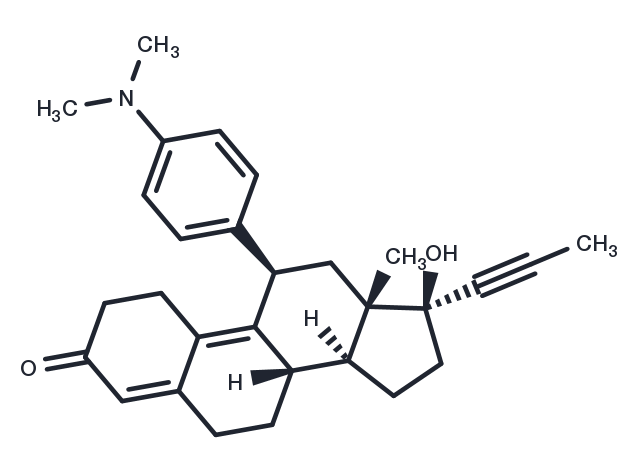Powder: -20°C for 3 years | In solvent: -80°C for 1 year


Mifepristone (C-1073) is a Progestin Antagonist. The mechanism of action of mifepristone is as a Progestational Hormone Receptor Antagonist.

| Pack Size | Availability | Price/USD | Quantity |
|---|---|---|---|
| 50 mg | In stock | $ 37.00 | |
| 100 mg | In stock | $ 48.00 | |
| 200 mg | In stock | $ 61.00 | |
| 500 mg | In stock | $ 84.00 | |
| 1 mL * 10 mM (in DMSO) | In stock | $ 50.00 |






| Description | Mifepristone (C-1073) is a Progestin Antagonist. The mechanism of action of mifepristone is as a Progestational Hormone Receptor Antagonist. |
| Targets&IC50 | Progesterone receptor:0.2 nM, GR:2.6 nM |
| Kinase Assay | Glucocorticoid receptor (GR) antagonist activity, Progesterone receptor (PR) antagonist activity: T47D alkaline phosphatase assay: T47D human breast cancer cells are plated in 96-well tissue culture plates at 104 cells per well in assay medium [RPMI medium without phenol red containing 5% (v/v) charcoal-treated FBS and 1% (v/v) penicillin–streptomycin]. Two days later, the medium is decanted and Mifepristone or control is added at a final concentration of 0.1% (v/v) dimethylsulfoxide in fresh assay medium. Twenty-four hours later, an alkaline phosphatase assay is performed using a SEAP kit. The medium is decanted and the cells are fixed for 30 minutes at room temperature with 5% (v/v) formalin. The cells are washed once at room temperature with Hanks' buffered saline solution. Equal volumes (0.05 mL) of dilution buffer, assay buffer, and 1:20 substrate/enhancer mixture are then added. After 1-hour incubation in the dark at room temperature, the lysate is transferred to a white 96-well plate and luminescence is read using a LuminoSkan Ascen. A549 reporter assay: A549 human lung carcinoma cells are washed with OPTI-MEM I. The medium is removed and lipid–DNA complex solution (1.5 μg/mL of GRE-luciferase reporter DNA in 8.5 mL OPTI-MEM I plus 6 μL/mL DMRIE-C reagent in 8.5 mL OPTI-MEM I, combined, mixed and incubated at room temperature for 40 minutes) is overlayed onto the cells in a T160 flask. The cells are incubated for 16 hours at 37 °C in a CO2 incubator. The DNA-containing medium is removed and 30 mL of growth medium containing 5% (v/v) charcoal-treated fetal bovine serum is added. After 5-6 hours, the cells are seeded in 96-well plates and incubated overnight at 37 °C. Mifepristone is then added to each well followed by dexamethasone as a corticoid challenge. The cells are incubated for 24 hours. Luciferase assay buffer is added to each well and the cells are incubated for 30 minutes at room temperature.Luciferase activity is measured in a DYNEX Microlite plate on a TopCount. |
| Cell Research | Cell growth is evaluated in various ovarian cancer cell lines that are subjected to dose-response or time course treatments. Media containing each of the doses of fresh steroids is replaced every 24 hours. Control groups of cells are treated with vehicle ethanol at a final concentration of less than 0.05%. Number of viable cells is evaluated by trypsinization and counting in a hemocytometer chamber using trypan blue dye exclusion. Experiments are conducted in media without phenol red and supplemented with charcoal extracted fetal bovine serum, or media containing unextracted serum and having phenol red. Similar results are obtained with both media preparations; therefore, after performing the growth curves, all subsequent experiments are conducted using media with unextracted serum and in the presence of phenol red. When indicated, the proliferation IC50s are calculated using software designed to study drug interaction. (Only for Reference) |
| Synonyms | C-1073, RU486, RU 38486 |
| Molecular Weight | 429.59 |
| Formula | C29H35NO2 |
| CAS No. | 84371-65-3 |
Powder: -20°C for 3 years | In solvent: -80°C for 1 year
DMSO: 43 mg/mL (100 mM)
Ethanol: 21.5 mg/mL (50 mM)), Heating is recommended.
You can also refer to dose conversion for different animals. More
bottom
Please see Inhibitor Handling Instructions for more frequently ask questions. Topics include: how to prepare stock solutions, how to store products, and cautions on cell-based assays & animal experiments, etc.
Mifepristone 84371-65-3 Autophagy Endocrinology/Hormones Immunology/Inflammation Others NO Synthase Progesterone Receptor Estrogen/progestogen Receptor Glucocorticoid Receptor RU38486 Inhibitor C-1073 RU-38486 NOS RU486 RU 38486 Nitric oxide synthases NR3C3 inhibit C1073 RU-486 C 1073 RU 486 inhibitor
